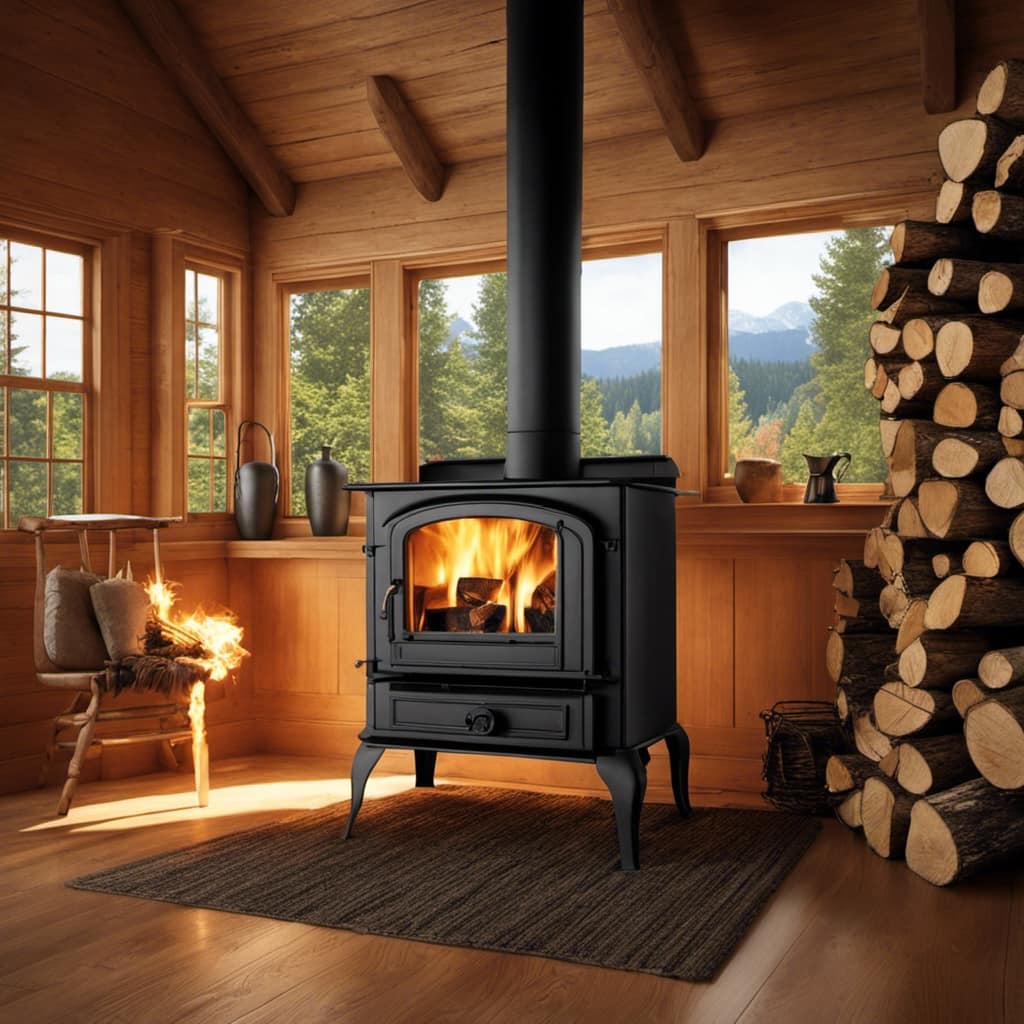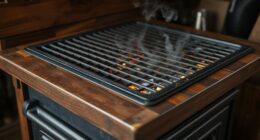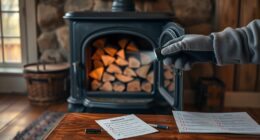
As we move from one season to another, it is important to make sure that your wood stove is prepared for the upcoming colder weather. A well-maintained wood stove in your home can offer both warmth and coziness. Let’s begin preparing it now!
I’ll guide you through the essential steps to ensure your wood stove is in top shape, from checking ventilation to stocking up on firewood.
With a little preparation, you’ll be ready to embrace the cozy ambiance and crackling warmth of your wood stove all season long.
Key Takeaways
- Proper ventilation maintenance is crucial for safe and efficient operation of a wood stove.
- Cleaning and maintaining the chimney and flue ensures proper airflow and increases stove performance.
- Inspecting and repairing damaged components, such as cracks or leaks, is important for efficiency and safety.
- Stocking up on well-seasoned hardwood and ensuring safety measures are in place, such as carbon monoxide detectors and fire extinguishers, is essential for preparing a wood stove for the season.
Checking for Proper Ventilation
I’m making sure to check for proper ventilation before starting the wood stove for the season. Ventilation maintenance is crucial for the safe and efficient operation of a wood stove. It ensures that the combustion process is optimal and that harmful gases, like carbon monoxide, are properly vented outside.

One of the most important aspects of ventilation maintenance is ensuring that the chimney and flue are clean and clear of any debris or obstructions. This allows for proper airflow in the wood stove, which is essential for achieving a complete and efficient burn.
It’s also important to check the seals and gaskets around the stove to ensure that there are no air leaks. Proper ventilation not only increases the performance of the stove but also reduces the risk of carbon monoxide poisoning and other safety hazards.
Cleaning the Chimney and Flue
To ensure proper ventilation, I’m going to clean the chimney and flue of any debris or obstructions. This is an essential step in maintaining the efficiency and safety of a wood stove. Here’s how I’ll do it:
-
Gather the necessary cleaning tools: chimney brush, chimney rods, goggles, gloves, and a dust sheet.

-
Start by removing any loose debris from the chimney and flue using a chimney sweep or a brush attached to the rods.
-
Use the chimney brush to thoroughly scrub the interior walls of the chimney, paying attention to areas where creosote buildup is likely.
Cleaning the chimney and flue is just the first step in preparing a wood stove for the season. Once this is done, it’s important to inspect and repair any damaged components to ensure optimal performance and safety.
Inspecting and Repairing Damaged Components
I’ll assess the wood stove’s condition and identify any damaged components that need inspecting and repairing. One of the most common issues with wood stoves is cracks in the firebox or other parts of the stove. These cracks can lead to inefficiency and even pose a safety hazard. To repair cracks, I’ll use a high-temperature epoxy or refractory cement, ensuring a secure and durable fix. Additionally, checking for leaks is essential to maintain the stove’s efficiency. Leaks can occur in the doors, gaskets, or flue pipe connections. By inspecting these areas and replacing any worn-out gaskets or damaged parts, I can ensure that the stove operates at its peak performance.

To visually represent the importance of inspecting and repairing damaged components, here is a table showcasing the potential consequences of neglecting these tasks:
| Neglected Tasks | Consequences |
|---|---|
| Ignoring cracks | Reduced efficiency, potential fire hazard |
| Not checking for leaks | Energy wastage, poor heating performance |
| Neglecting gasket replacement | Air leaks, decreased heat retention |
| Ignoring damaged parts | Safety hazards, compromised stove functionality |
Taking the time to inspect and repair damaged components is crucial for maintaining the wood stove’s performance, efficiency, and safety.
Stocking up on Firewood and Fuel
Ensuring a sufficient supply of firewood and fuel is essential for maintaining warmth during the winter months. Here are three important things to consider when stocking up on firewood and fuel:
-
Storing firewood properly: It’s crucial to keep your firewood dry and protected from the elements. This helps prevent mold and decay, ensuring that you have dry and usable wood when you need it most.

-
Choosing the right fuel for your wood stove: Different wood stoves require different types of fuel. It’s important to know what type of wood your stove is designed for, as using the wrong fuel can lead to inefficient burning and potential damage to your stove.
-
Quantity and quality: Stocking up on enough firewood is important, but so is the quality of the wood. Opt for well-seasoned hardwood as it burns longer and produces more heat.
By following these guidelines, you can ensure a steady supply of firewood and fuel to keep your wood stove running efficiently and your home warm during the winter months.
Now, let’s discuss ensuring safety measures are in place to further enhance your wood stove experience.

Ensuring Safety Measures Are in Place
I have implemented several safety measures, including installing a carbon monoxide detector and ensuring a fire extinguisher is readily accessible near the wood stove.
When it comes to fire extinguisher placement, it’s crucial to have it within easy reach, preferably mounted on the wall or placed on a stable surface close to the stove. This ensures that in case of a fire emergency, you can quickly access the extinguisher and extinguish the flames before they spread.
Additionally, installing a carbon monoxide detector is essential to detect any buildup of this deadly gas. It should be placed in a central location, away from any obstructions, and tested regularly to ensure it’s functioning properly.
Frequently Asked Questions
How Often Should I Clean My Wood Stove Chimney and Flue?
I clean my wood stove chimney and flue at least once a year to ensure proper airflow and prevent buildup of creosote. It’s important to use dry, seasoned firewood to reduce the risk of chimney fires.

Can I Use Any Type of Firewood in My Wood Stove?
I always consider firewood selection carefully when using my wood stove. It’s important to follow best practices to ensure efficient burning and minimize creosote buildup. Different types of firewood have varying moisture content and heat output.
What Are Some Common Signs of Damaged Components in a Wood Stove?
Common signs of damaged components in a wood stove include rust, cracks, loose or broken parts, and smoke leakage. It’s important to regularly inspect and maintain your stove to ensure it functions safely and efficiently.
Is It Necessary to Have a Carbon Monoxide Detector Installed Near the Wood Stove?
Yes, it’s crucial to have a carbon monoxide detector near your wood stove. Carbon monoxide risks are serious, and a detector will ensure wood stove safety by alerting you to any dangerous levels.
Are There Any Specific Weather Conditions That Can Affect the Performance of a Wood Stove at Sea?
There are specific weather conditions at sea that can impact the performance of a wood stove. High winds and rough seas can make it difficult to maintain a steady fire and control heat output.

Conclusion
In conclusion, preparing a wood stove for the season is a crucial step in ensuring a warm and cozy winter.
By checking for proper ventilation, cleaning the chimney and flue, inspecting and repairing damaged components, and stocking up on firewood and fuel, you can enjoy safe and efficient heating.
Remember, safety measures are key to prevent any accidents or mishaps.
So, let’s get ready to snuggle up by the fire and embrace the nostalgic charm of the wood stove.

Growing up surrounded by the vast beauty of nature, Sierra was always drawn to the call of the wild. While others sought the comfort of the familiar, she ventured out, embracing the unpredictable and finding stories in the heartbeat of nature.
At the epicenter of every remarkable venture lies a dynamic team—a fusion of diverse talents, visions, and passions. The essence of Best Small Wood Stoves is crafted and refined by such a trio: Sierra, Logan, and Terra. Their collective expertise has transformed the platform into a leading authority on small wood stoves, radiating warmth and knowledge in equal measure.











